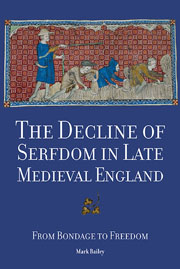Book contents
- Frontmatter
- Contents
- List of Maps
- List of Graphs
- List of Tables
- Acknowledgements
- Abbreviations
- Part I The Decline of Serfdom: Questions and Approaches
- Part II Case Studies
- 5 Reassessing the Decline of Serfdom: Methods and Sources
- 6 Walsham-le-Willows
- 7 Merton College, Oxford
- 8 Aldham
- 9 Tingewick and Upper Heyford
- 10 The Abbot of Bury St Edmunds
- 11 The Dukes of Norfolk
- 12 Miscellaneous manors
- Part III Conclusions
- Appendix: List of original sources used in this study
- Chronology
- Bibliography
- Index
5 - Reassessing the Decline of Serfdom: Methods and Sources
from Part II - Case Studies
Published online by Cambridge University Press: 05 March 2014
- Frontmatter
- Contents
- List of Maps
- List of Graphs
- List of Tables
- Acknowledgements
- Abbreviations
- Part I The Decline of Serfdom: Questions and Approaches
- Part II Case Studies
- 5 Reassessing the Decline of Serfdom: Methods and Sources
- 6 Walsham-le-Willows
- 7 Merton College, Oxford
- 8 Aldham
- 9 Tingewick and Upper Heyford
- 10 The Abbot of Bury St Edmunds
- 11 The Dukes of Norfolk
- 12 Miscellaneous manors
- Part III Conclusions
- Appendix: List of original sources used in this study
- Chronology
- Bibliography
- Index
Summary
Part I explored how the decline of serfdom impacted upon the economic and social history of England, and then surveyed current opinion on the chronology and causes of its decline. Part II presents the fruit of new research into this subject. Thus, at one level, this section adds more local examples to the existing stock of knowledge. Yet, at another level, it attempts to go beyond previous research to provide more precision in the chronology and causes of decline by using a different methodology to those deployed in previous studies.
This new approach proceeds from three simple assumptions. The first is that the key characteristics of villeinage on the eve of the Black Death must be explicitly defined if its subsequent decline is to be charted effectively: if they are ambiguous or unstated, then there is no reliable baseline from which to trace the decline. The second assumption is that, having established those key characteristics, the chronology of decline of each of them must be plotted as precisely as the sources allow for each individual manor. Finally, the manors used in the study should be representative of the different types of manor found in England, and they should be located in more than one area of the country, in order to increase the typicality of the research findings.
- Type
- Chapter
- Information
- The Decline of Serfdom in Late Medieval EnglandFrom Bondage to Freedom, pp. 87 - 103Publisher: Boydell & BrewerPrint publication year: 2014

